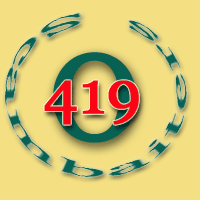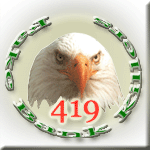
• Home •
Victim´s Story •
Fraud Prevention •
Project GSO •
Hall of Shame •
LINKS •

What is counterfeiting?
Counterfeiting
Counterfeiting is the act of manufacturing fake or altering genuine currency. The practice dates back to the Civil War, when a third of all U.S. currency was believed to be counterfeit. Counterfeit currency was especially difficult to catch during the 19th century, when more than 1,600 banks were permitted to manufacture their collective 7,000 kinds of coins.
Although instances of counterfeiting decreased dramatically after currency was nationalized in 1863, ever-advancing technology—such as high-resolution printers and copiers—has made it easy for even unskilled counterfeiters to forge counterfeit currency.
How can counterfeit currency be detected?
According to the United States Secret Service—established in 1865 to combat counterfeiting—the simplest way to identify counterfeit currency is to compare a suspect note with a genuine note, carefully observing the portrait, Federal Reserve and Treasury seals, border, serial numbers, and paper of the bills.
Counterfeit Bills
Portrait
While a genuine portrait is lifelike, appears to be two-dimensional, and stands out from the background, a counterfeit portrait is often dull and flat. Details are typically not distinct, and colors appear to be muddled and dark.
Federal Reserve and Treasury Seals
Genuine Federal Reserve and Treasury Seals are sharp-pointed, bright, and uniform, but counterfeit seals are uneven, blunt or broken.
Border
The borderlines on official currency are clear and solid, while lines on counterfeit bills may be blurred, disjoined, or indistinct.
Serial Numbers
Serial numbers on genuine bills are evenly spaced, printed in a unique font, and the same color as the Treasury Seal; on counterfeit bills, serial numbers tend to be a shade lighter or darker than the Treasury Seal, less uniformly spaced, and not properly aligned.
Paper
Genuine currency paper has red and blue fibers carefully threaded through it; the fibers are not raised and are clearly embedded. Counterfeit currency paper often has what appear to be red and blue fibers woven through it, but those fibers are actually ink lines printed directly onto the surface of the paper.
Counterfeit Coins
While counterfeit bills are used primarily as currency, counterfeit coins are intended to fool collectors by simulating old, rare pieces. Sometimes, counterfeiters might alter the dates of genuine coins, making them appear older or more rare than they actually are. Other times, counterfeiters mold fake coins by pouring liquid metal into casts. Authentic coins are stamped out on official machinery that ensures uniformity, but counterfeit coins usually lack uniformly ridged edges and may have dye marks or cracks.
How are counterfeiters punished?
The manufacture of counterfeit bills or coins or alteration of genuine currency, the possession of forged monies with intent to distribute, and the possession of printed reproductions (even photographs) of federal currency, postage stamps or U.S. securities are punishable by fine and/or up to 15 years in prison. The forgery, trafficking, or alteration of U.S. bonds or checks is punishable by fine and/or up to 10 years in prison.
If you are interested in learning more about counterfeiting, please contact a qualified criminal law attorney.
Did you know that ... Counterfeit Money, it’s Criminal?
It is a criminal offence to make, use or possess a counterfeit bank note.
You are not permitted to keep a counterfeit note even for the purposes of training or instruction. Any suspect note must be given to the police.
Under the Copyright Act, the Bank of Canada owns the copyright on all design elements used in Canadian bank notes. In order to avoid any civil proceedings, it is necessary to obtain a written authorisation from the Bank of Canada before reproducing any Canadian bank note images.
... counterfeit money is a serious concern in Canada?
According to the Royal Canadian Mounted Police, close to 10 million dollars in counterfeit money is seized each year in this country.
This type of crime is increasingly becoming a crime of choice among criminal organizations to finance their illegal activities.
... you can easily avoid becoming a victim of counterfeiting?
It only takes a few seconds to verify if a Canadian bank note is genuine.
Most counterfeit notes are of poor quality and can be easily detected.
The majority of victims are not familiar with bank note security features and rarely take the time to verify if a note is genuine.
... you can make a difference in the fight and prevention of bank note counterfeiting?
YOU can contribute to reduce counterfeiting through prevention and by reporting any relevant information that could lead to investigation or the arrest of counterfeiters.
"It’s up to you to make a difference. It’s your money, after all!"
... you are in possession of a counterfeit note or a suspected counterfeit note?
If you think that you have detected a counterfeit note, you should, if possible:
Keep the note and record all relevant information (denomination, serial number, etc.).
Record the details on how you received the note: time, context, description of the person who gave you the note, description of any accomplices, vehicle license plate number, etc. Contact your local police service.
Give the note to the police. Ask for a receipt. The note will be returned to you if it is determined to be genuine by the Bureau for Counterfeit and Document Examinations.
... you have information to report or you have witnessed criminal activities relating to counterfeiting?
Contact Info-Crime Quebec at 1 800 711-1800 .
Dial 911 for emergency assistance if you think your immediate safety is at risk.
Contact your local police.
What can you do to prevent this crime?
Familiarize yourself with the Canadian bank note security features: www.bankofcanada.ca - Verify systematically all the bank notes you receive.
- Contact your local police.
- Report any relevant information to Info-Crime Quebec at 1 800 711-1800 .
Counterfeit Money, it’s Criminal!
Fighting Counterfeiting, it’s Everybody’s Business!
If you receive a counterfeit:
- Do not return it to the passer.
- Delay the passer if possible.
- Observe the passer's description, as well as that of any companions, and the license numbers of any vehicle used.
- Telephone your local police department or the United States Secret Service. These numbers can be found on the inside front page of your local telephone directory.
- Write your initials and the date on a blank portion of the suspect note.
- Do not handle the note. Carefully place it in a protective covering, such as an envelope.
- Surrender the note or coin only to a properly identified police officer or U.S. Secret Service agent.
Design Features For Newly Issued Currency
Because of the advances in color copier technology, two new security features are being added to U.S. currency. These new features appeared first in Series 1990, $50 and $100 Federal Reserve Notes. Additional denominations are gradually being phased in. Existing currency and the new series will co-circulate until existing currency is withdrawn at the Federal Reserve banks and branches. Withdrawal will be based on normal wear.
Microprinting
Concurrent with the addition of the security thread, a line of microprinting appears on the rim of the portrait on $50 and $100 denominations, beginning with Series 1990. The words "THE UNITED STATES OF AMERICA" are repeated along the sides of the portrait. As with the new security thread, the microprinting will also be gradually phased in on all denominations, with the possible exception of the $1 denomination.
To the naked eye, the microprinting appears as little more than a solid line and can only be read by using magnification. Neither of the new security features can be accurately reproduced by an office machine copier.
Inscribed Security Thread
A clear, inscribed polyester thread has been incorporated into the paper of genuine currency. The thread is embedded in the paper and runs vertically through the clear field to the left of the Federal Reserve seal on all notes except the $1 denomination. If it is decided to use the thread in the $1 denomination, it will be located between the Federal Reserve seal and the portrait.
Printed on the thread is a denomination identifier. On $20 denominations and lower, the security thread has "USA" followed by the written denomination. For example, "USA TWENTY USA TWENTY" is repeated along the entire length of the thread. Higher denominations have "USA" plus the numerical value, such as "USA 50 USA 50" repeated along the entire length of the thread. The inscriptions are printed so that they can be read from either the face of the back of the note. The thread and the printing can only be seen by holding the note up to a light source.
Illustration of Currency, Checks or Other Obligations.
The law sharply restricts photographs of other printed reproductions of paper currency, checks, bonds, revenue stamps, and securities of the United States and foreign governments.
Color reproductions of paper currency, checks, or bonds for any purpose are illegal. No color other than black and white may be used.
Photographic or other likenesses of United States and foreign currencies are permissible for any non-fraudulent purpose provided the items are reproduced in black and white and are less than 3/4 or greater than 11/2 times the size, in linear dimension, of any part of the original item being reproduced. Negatives and plates used in making the likenesses must be destroyed after their use for the purpose for which they were made. This policy permits the use of currency reproductions in commercial advertisements, provided they conform to the size and color restrictions.
Criminal Law Attorneys addresses:
The Law Offices of Sara Azari
Good People have Good Reputations We Protect Them!
Please Call (866) 421-4225 or Click Here for more information!
The Law Offices of Erik Friis
Attorney for DUI, DWI, and Criminal Cases
CALL NOW at (619) 365-9108 & Website coming soon!
The Law Offices of Broderick H. Brown
If You Have Been Accused, YOU HAVE RIGHTS!
CALL NOW at (866) 421-1311 or CLICK HERE for our website!
Atkins & Markoff
Experienced Criminal Attorneys
Contact us at 1-800-442-0607 or CLICK HERE for more information!
Stephen A. Nicholas, Attorney at Law
23 Years Experience of Criminal Defense
CALL 210-222-2288 NOW or CLICK HERE to Visit Our Website!!
Melrose, Seago & Lay, P.A.
Experienced Criminal Defense Lawyers
CALL US at (866) 277-3807 or CLICK HERE for more information! www.criminallawfyi.com
© by GSO • Contact